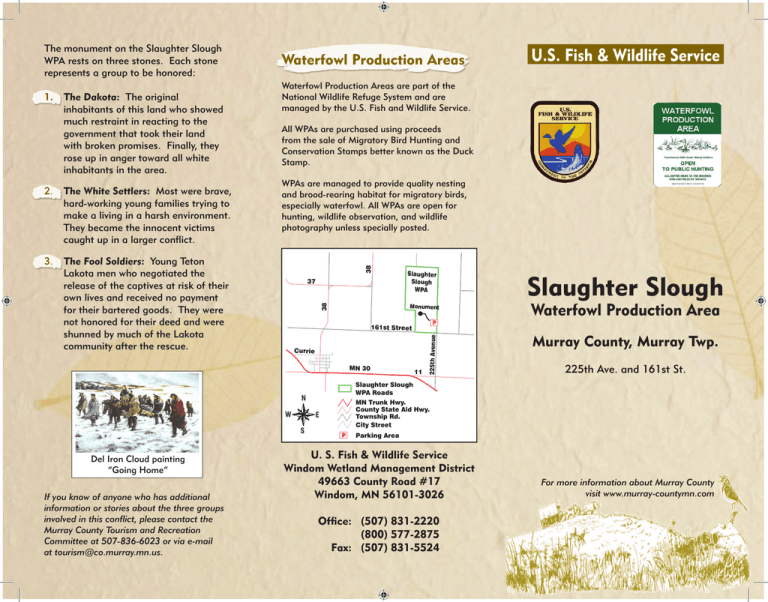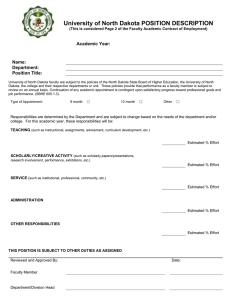Slaughter Slough
advertisement

2. The White Settlers: Most were brave, hard-working young families trying to make a living in a harsh environment. They became the innocent victims caught up in a larger conflict. 3. The Fool Soldiers: Young Teton Lakota men who negotiated the release of the captives at risk of their own lives and received no payment for their bartered goods. They were not honored for their deed and were shunned by much of the Lakota community after the rescue. All WPAs are purchased using proceeds from the sale of Migratory Bird Hunting and Conservation Stamps better known as the Duck Stamp. WPAs are managed to provide quality nesting and brood-rearing habitat for migratory birds, especially waterfowl. All WPAs are open for hunting, wildlife observation, and wildlife photography unless specially posted. 37 Slaughter Slough WPA Monument Currie If you know of anyone who has additional information or stories about the three groups involved in this conflict, please contact the Murray County Tourism and Recreation Committee at 507-836-6023 or via e-mail at tourism@co.murray.mn.us. 11 Murray County, Murray Twp. 225th Ave. and 161st St. MN Trunk Hwy. County State Aid Hwy. Township Rd. City Street E S Waterfowl Production Area Slaughter Slough WPA Roads N W Slaughter Slough P 161st Street MN 30 Del Iron Cloud painting “Going Home” U.S. Fish & Wildlife Service Waterfowl Production Areas are part of the National Wildlife Refuge System and are managed by the U.S. Fish and Wildlife Service. 225th Avenue The Dakota: The original inhabitants of this land who showed much restraint in reacting to the government that took their land with broken promises. Finally, they rose up in anger toward all white inhabitants in the area. 38 1. Waterfowl Production Areas 38 The monument on the Slaughter Slough WPA rests on three stones. Each stone represents a group to be honored: P Parking Area U. S. Fish & Wildlife Service Windom Wetland Management District 49663 County Road #17 Windom, MN 56101-3026 Office: (507) 831-2220 (800) 577-2875 Fax: (507) 831-5524 For more information about Murray County visit www.murray-countymn.com Lake Shetek and the U.S. Dakota War — August 1862 Following the treaties signed in 1851 at Traverse des Sioux and Mendota, the Dakota people of Minnesota were forced onto reservations along both the north and south sides of the Minnesota River from Lake Traverse and Big Stone Lake to Little Rock Creek, just east of the recently constructed Fort Ridgley. A rush of white settlers followed the construction of the fort. Oblivious to the desperation of the Dakota people caused by broken promises, the corruption of traders and the political agenda of many high officials, over fifty people began to carve out a life for themselves at Lake Shetek. On August 18, 1862, the powder keg erupted at the Lower Sioux Agency, soon spreading to Fort Ridgley and New Ulm. In the early morning of August 20, 1862, Lean Bear and White Lodge led Dakota soldiers against families living at Shetek. The northernmost cabin on the peninsula jutting into Lake Fremont, the Aaron Myers family homestead, was spared. This may be because, on at least one occasion, Mr. Myers had “healed” injured Dakota. The Myers family made their way toward New Ulm, unaware of all that was to transpire that day, other than the death of John Voight. Voight, living at the Hurd cabin on the north end of Bloody Lake, was killed, as was Andreas Koch, living on the south end of the same lake. Mrs. Hurd and her two young children headed for New Ulm while Mrs.Andreas Koch fled down the lake toward her neighbors. Charlie Hatch, a brother to Mrs. Everett, was en route to the Hurd cabin that very morning and discovered the body of Voight. He then began a desperate race back down the lake to warn his family and other settlers. In an early Charlie Hatch newspaper account he is called “The Paul Revere of Lake Shetek.” Hatch was too late to help Mr. Koch, but did get ahead of the Dakota to warn the others. They decided to make a stand at the Wright cabin, where thirty-four men, women and children gathered in fear and apprehension. Negotiations took place with Pawn, a Dakota often living at the lake and well-known to the Shetek settlement. After much discussion, the settlers decided that they could not withstand a prolonged siege in that cabin. They finally agreed to the offer of safety if they would leave and go back East. Soon they were in a single wagon driven by a team of horses heading east on the New Ulm-Sioux Falls trail that crossed the Des Moines River just south of the present dam. Slightly less than three miles down the trail, the small group saw several Dakota riding toward them, Pawn among them. The families all fled down an incline into the tall slough grass. Gunfire was exchanged and Chief Lean Bear was killed as he was taking the settler’s horses. One or two other Dakota were killed. Two white men escaped through the neck of the slough into the much larger wetland before the Dakota were able to cut off this route of escape. The others were surrounded. When grass moved or a shot from the slough rang out, the Dakota would pour gunfire into the area. Soon John Eastlick had been killed Mrs. Lavina Eastlick and five other men and her two sons. wounded. Pawn offered safety if the women and children came out. Afraid of a charge into the slough and fearing the Dakota warriors might set the grass aflame, they decided to accept the proposal. Unfortunately, several women and children were killed after leaving the slough. The seriously injured Mrs. Lavina Eastlick and two of her sons eventually reached safety. Eleven captives were taken north and west by White Lodge and his warriors. A woman and child escaped, and an infant died. The remaining two women and six children were Martin Charger, Leader held captive for of the Fool Soldiers three months under very difficult circumstances. They were rescued in early November 1862 by a group of young Teton Lakota men who bargained for their release. These young men were known as “Fool Soldiers.”


